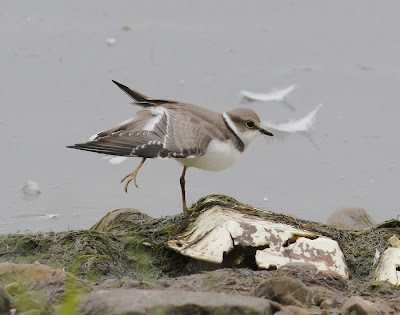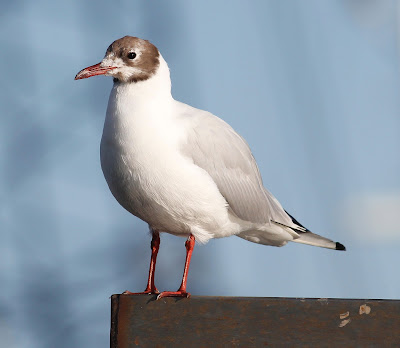For 1300 I had an appointment for a dose of ‘flu vaccine to look forward to, but at last a bright, wind and rain free morning in which to enjoy a few hours birding.
From Fluke Hall I set out towards the sea wall across the maize and wheat fields where there’s a reasonable path which avoids slushing through the soggy stubble. There are always birds to see about the shooter’s fields, ditches and pools, as long as you take care to miss the actual shoot days when there are no birds about and steel shot will fall on your head.
Pilling, Fluke Hall fields
On the edge of the wood I could see 4 Jays moving through the trees calling as they went. There were a number of Chaffinches about but too far to count, although I found 5 or 6 Tree Sparrows and a couple of Reed Buntings near the gate again. Skylarks weren’t as obvious today with none passing overhead just 4 or 5 resident ones on the sea wall and stubble, plus another 2 Reed Buntings along the ditch.
The Red-legged Partridge still number in the hundreds, so I’m thinking there haven’t been too many shoots just yet. From the stile I even managed to get close to one of the white ones which are as wild and wary as the normal brown ones. Close to they are actuallly quite smart looking. Pity they end up in a cooking pot.
Red-legged Partridge
From the fresh 4x4 tracks on the mud I knew the guys who feed the pool had beat me to it, so no Teal or Black-tailed Godwits to enjoy today, just the usual single call and then brief views of the back end of a Kingfisher whizzing along the dyke and over the sea wall. So I thought to check where the blue flash had gone and also count the Whoopers as well - no sign of the majestic fisher from the wall but 74 Whooper Swans, 2 Greylag and 8 Mute Swan to count. So more pictures of Whooper Swan to follow, and a Mute Swan for size comparison.
Whooper Swan and Mute Swan
Whooper Swan
With not much else doing I realised I’d missed out on Conder Green for a week or two so motored towards there.
Interestingly a Spotted Redshank is still there in the main creek, as is a Common Sandpiper and it’s not beyond the bounds of possibility that both might winter on site, the latter species the favourite to do so. Just 12 common Redshank and a single Curlew in the near creek with circa 60 Teal and a Grey Heron.
Spotted Redshank
Common Sandpiper
Two Tufted Duck on the pool together with yet more Teal to make a total of more than 80 of the tiny duck. Looking for a fishy meal were a Little Egret, 7 Little Grebe and 2 Cormorant.
A walk along the railway track produced odds and ends like 5 Long-tailed Tit, 15 Chaffinch, 3 Goldfinch, 4 Meadow Pipits, 2 Skylark and 2 Pied Wagtail.
But I was running out of time and my appointment with a large, unfriendly needle beckoned. Log in soon to see how Another Bird Blog survived the ordeal and whether pain killers were required.
Linking today to Camera Critters and Anni's Birding Blog.
Linking today to Camera Critters and Anni's Birding Blog.













































































